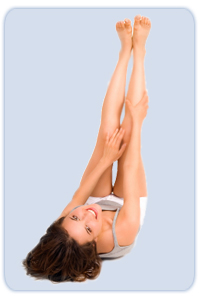We suggest for you...
![]()
 Varicose Veins
Varicose Veins
Varicose veins are permanent dilatation of veins, usually concentrated in the lower limbs.
Causes
Varicose vein is a chronic disease. When the wall of the vein is reached, expansion disrupts the unidirectional flow of blood to the heart because the valves can no longer work their antireflux functions. The vein is then overloaded with blood. In addition to his unsightly side , varicose vein is also a threat to the physical health.
In addition to age and gender, and in the case where heredity would not play crucial role, several factors may trigger the emergence of varicose veins.
Obesity, lack of exercise, working standing up all day, wearing tight-fitting clothes, heat exposure and carrying heavy loads repeatedly are examples.
Symptoms
Symptoms generally include heaviness sensations, swelling sensations, tingling, pain and cramping. Varicose veins may also be visible or palpable and can be identified by swelling, dermatitis, eczema, oedema, healed or open ulcers or sinuous white atrophy.
The diagnosis must be made clinically and confirmed by Doppler sonography. If left untreated, varicose veins can lead to complications such as blood clots, bleeding and ulcers.
Information and advice
Although some prevention can be done in order to avoid the appearance of varicose veins, we must keep in mind that this is chronic disease as much functional than esthetic. It is recommended to consult a specialist who will take the necessary measures, depending on the particular case.
However, if one is at risk, it is recommended to avoid physical inactivity, to avoid quick gain or loss of weight, avoid exposure of heat sources that dilate the veins (hot baths, sauna, sun, etc.) and, in the case of women, to avoid contraceptive pill. The approach of menstruation is a propitious time for varicose veins to appear. Pregnant women are also highly subject to the formation of varicose veins.
Treatments
A lot of symptomatic treatments are available. This does not mean they treat the varicose vein itself.
Compression stockings are used to treat varicose pain as much as preventing the emergence of new ones. They act as a "second layer" of muscles that compress the veins and prevent the accumulation of blood in them. These stockings prevent the wounds from varicose veins and varicose ulcers, but as soon as you stop, varicose veins are regonflent.
To bring them in comfort, it is better to put them in the morning before they get up. In the enfilant in supine position, avoiding that a substantial amount of blood and did not descend stagnating, at least in part, in the legs. Ideally, they should be worn all day.
Long recognized as unattractive and awkward to put on the bottom of contention are now available in a variety of colors and styles to please all the closets. They may be localized in both pharmaceuticals and specialty shop in various forces of restraint.
Anti-inflammatory used to relieve in case of superficial phlebitis.
Medications veinotoniques, also called "phlébotoniques, these medications are used to strengthen and relax the walls of veins. They would thus relieve some symptoms. However, their use is not unanimous.
Sclerotherapy requires neither anesthesia, or recovery time. This treatment is ideal for beginners and varicose varicosities in the spider web. The doctor injects a solution irritant in small superficial veins exploded, causing the closure of these streaks. While the blood is forced from flowing to other non-varicose veins, the "bad" streaks became unnecessary subside gradually and usually does not leave traces.
A new form of sclerotherapy, microsclérothérapie, is particularly suitable for treating varicosities in the spider web.
If sclerotherapy may require several treatments on the same vein, the results are generally good. However, it in no way prevents the formation of new varicose veins in the surrounding, so that the results are not always permanent.
The curative treatments are also numerous:
The veinotomie ambulatory. During this intervention, we extract the small veins attacks with micro-incisions using a special hook.
A variety of laser treatment is offered, on the surface of the skin as inside the vein, the so-called laser endoveineux. A laser fiber is inserted into the vein sick. The laser destroys the vein in forcing her to close in on itself.
CHIVA (Surgery hemodynamics of venous insufficiency CLINIC). Still under discussion, this operation reduces the venous pressure without removing the veins. The superficial veins affected are ligaturées, forcing blood to pass through the deep veins. Once ligaturées, they can fill more deflating for themselves and become less visible and less painful. This intervention is aimed at people who have a slight impact veins.
Endoscopic vein surgery. This intervention is relatively slight in the most serious cases where ulcers in the legs appeared. It is practiced with a tiny video camera that we insert into the leg through a small incision to view and close veins.
Éveinage. Also called "stripping", the traditional used for serious cases and involves removing the veins of each of the affected leg, through small incisions. Depending on the age and the severity of the problem, treatment may require hospitalization of one to five days followed by a convalescence ranging from 3 to 21 days.



